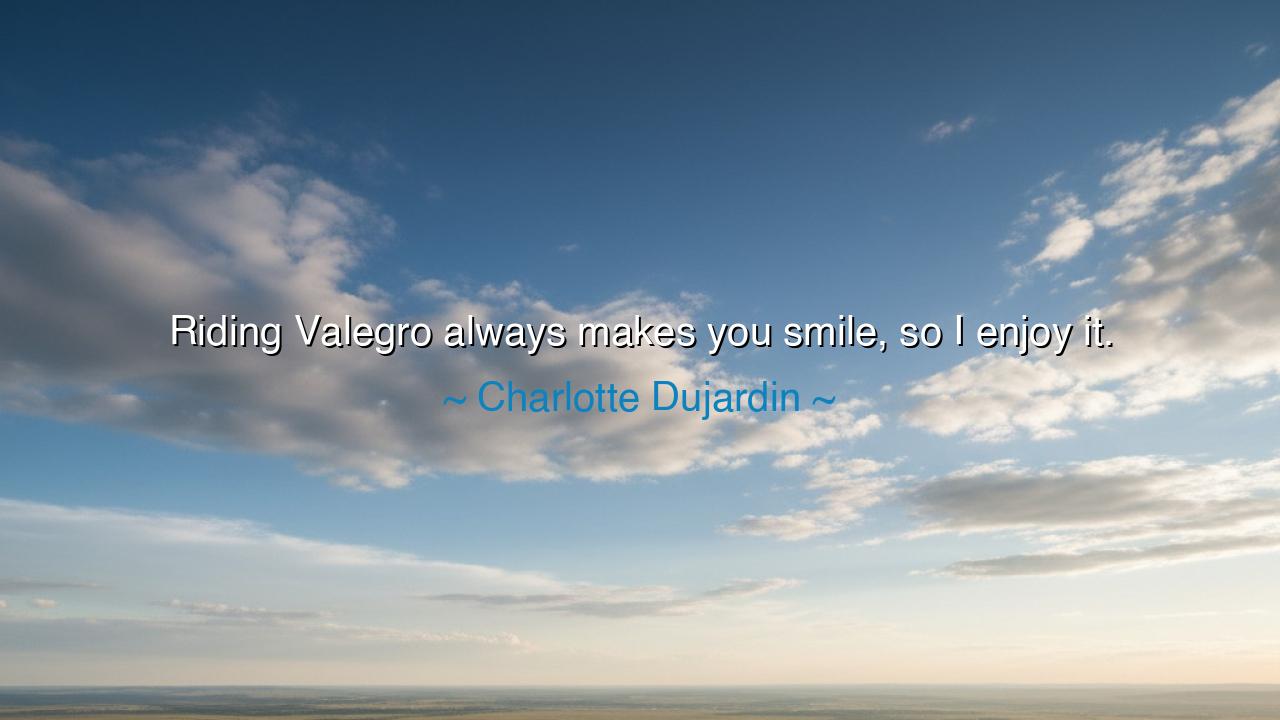
Riding Valegro always makes you smile, so I enjoy it.






The words of Charlotte Dujardin are spoken with the joy of one who has found harmony between human and beast: “Riding Valegro always makes you smile, so I enjoy it.” Though brief, this saying carries the depth of ages, for it speaks to the union of effort and delight, the merging of discipline and love, the bond between rider and horse that has guided humanity since the dawn of history.
To smile while riding is not simply to express amusement; it is the mark of a spirit in perfect accord with its task. The horse Valegro, trained to the highest standard of dressage, demanded discipline, focus, and mastery from his rider. Yet rather than burden, he became a source of joy. This is the heart of Dujardin’s words: when labor and joy are wedded together, when skill and spirit align, the result is not toil but delight. It is a reminder that the greatest achievements of life are not meant to weigh us down but to lift us up.
History gives us many such examples. Think of Alexander the Great and his horse Bucephalus. When all others declared the beast untamable, Alexander mastered him, not through force, but through understanding. From that day forward, the horse carried him across empires, and their partnership became legend. To ride Bucephalus was not merely to command a steed, but to share in a bond that brought both pride and joy. In the same way, Dujardin speaks of Valegro not as a tool of victory but as a companion whose presence made her smile, even amidst the pressure of Olympic competition.
The enjoyment she describes is no shallow pleasure. It is the fruit of countless hours of training, of setbacks, of persistence. True joy in mastery is born not from ease but from labor overcome. The farmer who harvests after months of toil, the poet who finds the perfect phrase after endless revisions, the musician who draws music from years of practice—all smile in the moment when effort blossoms into beauty. Riding Valegro, for Dujardin, was such a moment made living: the culmination of labor transformed into harmony, and harmony transformed into joy.
Her words also reveal the sacred truth that joy must remain central, even in the pursuit of greatness. Too often, achievement becomes a burden, excellence a prison. But when one can still smile in the very midst of striving, then success is not hollow but alive. The great danger of ambition is that it drains the soul of delight. The great wisdom of Dujardin is that she never lost sight of the smile, the simple delight that first drew her to the saddle.
The lesson here is profound: seek the pursuits that make you smile, not only the ones that bring you accolades. Let your labors be chosen not solely for reward, but for the joy they bring in the doing. Whether it is the artist at the canvas, the teacher in the classroom, the athlete with their craft—choose those paths where effort is met with delight, where discipline blooms into laughter. For only there will your spirit find both excellence and peace.
Therefore, let us act with intention. Find your own Valegro, that task, calling, or companion that fills you with joy even in the midst of labor. Embrace it, train for it, give yourself to it fully, but never lose sight of the smile. For the smile is the sign that you are not only living but living well, not only achieving but flourishing.
Carry forward Charlotte Dujardin’s wisdom: “Riding Valegro always makes you smile, so I enjoy it.” May it remind you that life’s truest greatness is not only in medals won or victories claimed, but in the joy that remains through the struggle, the joy that makes the journey itself worth riding.






AAdministratorAdministrator
Welcome, honored guests. Please leave a comment, we will respond soon